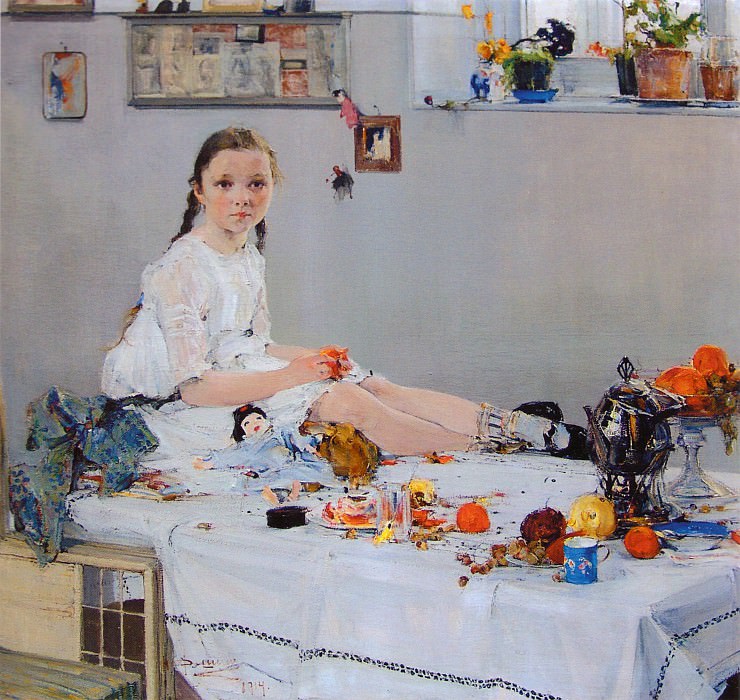Portrait of Vari Adoratskaya (1914) Nikolay Feshin (1881-1955)
Nikolay Feshin – Portrait of Vari Adoratskaya (1914)
Edit attribution
Download full size: 2395×2268 px (2,0 Mb)
Painter: Nikolay Feshin
N. I. Feshin is an artist who can combine several directions in his work, and his portraits are always characteristic. One of the painter’s striking works is Portrait of Varya Adoratskaya. The canvas depicts a girl who sits on a table. The furnishings in the room are modest, but many details are scattered, which forms a mess. Such an environment is typical for children of this age. The girl looks about ten years old, but she has the look of a completely adult.
Description of the painting "Portrait of Varya Adoratskaya" by Nikolai Feshin
N. I. Feshin is an artist who can combine several directions in his work, and his portraits are always characteristic. One of the painter’s striking works is Portrait of Varya Adoratskaya.
The canvas depicts a girl who sits on a table. The furnishings in the room are modest, but many details are scattered, which forms a mess. Such an environment is typical for children of this age.
The girl looks about ten years old, but she has the look of a completely adult. Her eyes convey the depth of thought of a person who has learned the world. It would seem that the child is not yet worried about anything, but the depth of her eyes is amazing. They express wariness and restraint.
The artist very accurately traced the details and background. Many objects are depicted clearly and understandably. Even details can be discerned in the scattered toys. It is fleetingly possible to mistake the heroine for a large doll as well. She seems to be frozen in perplexity among the children’s things.
The painter has depicted childhood as such. Play and pranks, carefree and naïve. The girl’s white dress emphasizes purity, two pigtails complete the image of a schoolgirl.
Normal bright room without frills painted with bright details, which are chaotically scattered. This is what childhood is all about. Children bring brightness and chaos to life, and that is the beauty of their presence. The place was not chosen by chance, it serves as the perfect backdrop for the girl.
The painter is very attentive to detail, there are no coincidences and coincidences in his works. Forty years after writing the work, a woman who posed for this painting as a child showed up. She gave a detailed account of exactly how the process itself took place, revealing the veil of all the hardships of the sitter.
It was terribly uncomfortable to sit, and prolonged work did not bring pleasure. The image of the girl and accumulates the infinity of thoughts expressed in a single glance of the child.
Кому понравилось
Пожалуйста, подождите
На эту операцию может потребоваться несколько секунд.
Информация появится в новом окне,
если открытие новых окон не запрещено в настройках вашего браузера.
You need to login
Для работы с коллекциями – пожалуйста, войдите в аккаунт (open in new window).




















COMMENTS: 12 Ответы
я думаю что он много картин рисует
бик каты уйлыйсын
даа булдыра бу кыз
бу кыз вообще молодец!!!
Сочинение! (
матуръ
инша бик үк ошап бетми укучы язганга...
vostorg!!!
кая инша????
шешынысын, омынга кут
Прекрасная картина! Я в восхищении!
You cannot comment Why?
The painting depicts a young girl, Vari Adoratskaya, sitting on a table covered with a white tablecloth. She is wearing a simple white dress and has her hair in braids. Her legs are extended across the table, and she is holding a small orange object in her hands, perhaps a fruit or a toy.
The table is cluttered with various items, suggesting either a meal that has just finished or a playful disarray. There is a doll lying on the tablecloth near the girls legs, along with scattered toys and what appears to be remnants of food and drink, like oranges, grapes, and a coffee pot. The background is a neutral, muted gray wall, with a window sill in the upper part of the painting featuring potted plants and decorative objects. There are also framed pictures and what look like small figurines or cutouts attached to the wall.
The overall impression is one of domestic intimacy and a moment captured in time. The subtexts of the painting could include: